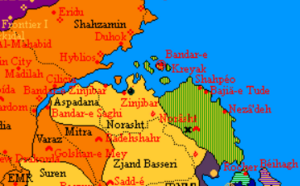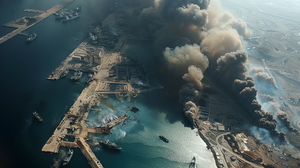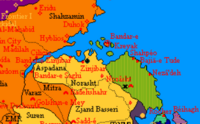Bandar-e Kreyak Orbital Strike
| Bandar-e Kreyak Orbital Strike | |||||||
|---|---|---|---|---|---|---|---|
| Part of the Alexandrium Wars, Gulf of Zinjibar campaign | |||||||
  Top: (1) Map of the Gulf of Zinjibar in 1738 AN; Bottom: (2) A high-resolution aerial surveillance drone photo showing extensive damage to Bandar-e Kreyak harbor. |
|||||||
|
|||||||
| Belligerents | |||||||
| Commanders and leaders | |||||||
| Units involved | |||||||
| |||||||
| Strength | |||||||
| 2 Damocles-class orbital bombardment platforms |
|
||||||
| Casualties and losses | |||||||
| None |
|
||||||
The Bandar-e Kreyak Orbital Strike was a precision orbital bombardment operation conducted by the Natopian Spacefleet against corsair fleet facilities in Bandar-e Kreyak, the capital of Jazir-e Kreyak, on 13.V.1738 AN. The strike, carried out at the request of the Suren Confederacy and coordinated through the Trans-Euran Command, targeted the main base of operations for corsair forces that had been conducting raids against Raspur Pact shipping in the Gulf of Zinjibar. The attack resulted in the destruction of significant portions of the corsair fleet and severely damaged the port's ability to support further naval operations.
Background

Since 1722 AN, the islands of Jazir-e Kreyak had served as a primary base for the Confederacy of the Dispossessed to launch corsair raids against merchant shipping and naval vessels in the Gulf of Zinjibar. These attacks posed a significant threat to Raspur Pact maritime commerce, particularly affecting trade routes between Surenshahr and Nivardom. The Sazeman-e Ettela'at va Amniyat-e Suren had gathered extensive intelligence on the corsair operations through a network of informants and surveillance operations, identifying Bandar-e Kreyak's harbor as the main staging area for these raids.
By mid-1737 AN, the situation had become untenable for Raspur Pact shipping interests. A particularly brazen attack on an Alexandrium-carrying convoy in VIII.1737 AN prompted the Committee of Euran Salvation to formally request assistance from the Natopian Spacefleet in neutralizing the threat. The detailed intelligence provided by SAVAS, including precise coordinates of ammunition stores, fuel depots, and vessel concentrations, made an orbital strike a viable option for eliminating the corsair threat while minimizing potential civilian casualties.
Planning
The operation was planned jointly by the Natopian Spacefleet's 1st Orbital Strike Group and SAVAS targeting specialists. Admiral Charles Lascelles, commander of the Raynor Fleet, personally oversaw the mission planning, working closely with Ismail al-Osman, the Director of Intelligence for the Suren Confederacy. The strike plan called for a coordinated attack using two Damocles-class orbital bombardment platforms, targeting the harbor's military infrastructure while attempting to minimize damage to the surrounding civilian areas.
Key targeting priorities included:
- The main deep-water berths where larger corsair vessels were moored;
- Ammunition and fuel storage facilities;
- Ship repair facilities and dry docks;
- Command and control centers;
- Radar and coastal defense installations.
The Strike
At 0300 hours local time on 13.V.1738 AN, the Damocles-class platforms NSS Themis and NSS Nemesis assumed attack positions in geosynchronous orbit over Bandar-e Kreyak. Weather conditions were optimal, with clear skies providing excellent visibility for the platforms' targeting systems. The first wave of kinetic kill vehicles was launched at 0315 hours, consisting of precisely guided tungsten rods designed to penetrate hardened targets.
The initial impacts targeted the ammunition storage facilities, creating massive secondary explosions that illuminated the pre-dawn sky. Subsequent salvos systematically struck ship repair facilities, command centers, and vessels moored in the harbor. The precision of the strikes, guided by SAVAS intelligence, resulted in minimal collateral damage to civilian areas of the city while achieving maximum effect against military targets.
Aftermath
The strike effectively crippled the corsair fleet's ability to operate from Bandar-e Kreyak. Post-strike assessment by SAVAS indicated the destruction of approximately 17 major vessels and significant damage to at least 42 others. The port's military infrastructure was largely destroyed, with an estimated 80% of key facilities rendered inoperable. Casualty estimates ranged from 1,200 to 1,500 personnel, primarily military and corsair crew members present in the targeted areas.
The successful strike marked a turning point in the Gulf of Zinjibar campaign, significantly reducing the corsair threat to Raspur Pact shipping. It also demonstrated the effectiveness of combined space-based operations with ground intelligence, setting a precedent for future joint operations between the Natopian Spacefleet and SAVAS.
The Maritime Free Republic government of Jazir-e Kreyak, led by Yakub Akbar, subsequently sought negotiations with the Trans-Euran Command to discuss terms for ending corsair operations, though these talks would ultimately prove unsuccessful. The strike's demonstration of Raspur Pact orbital strike capabilities, however, served as a powerful deterrent against future large-scale corsair operations in the Gulf of Zinjibar region.